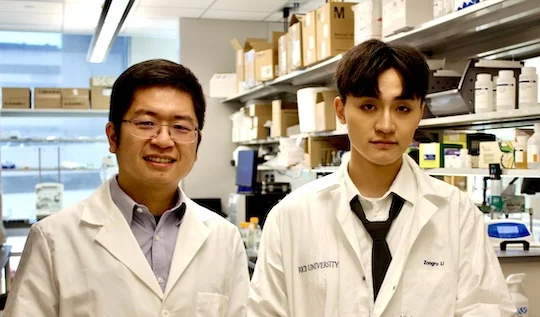Reviewed by Lexie CornerJul 16 2024
Engineers from Rice University have created ultrasmall, stable, gas-filled protein nanostructures that could transform medication administration and ultrasound imaging. This study was published in the journal Advanced Materials.
 Zongru Li (left) and George Lu. Image Credit: Anna Stafford/Rice University
Zongru Li (left) and George Lu. Image Credit: Anna Stafford/Rice University
The newly developed diamond-shaped 50 nm gas vesicles (50-NM GVs), which are about the size of viruses, are thought to be the smallest stable, free-floating structures for medical imaging ever made. This is in contrast to existing microbubbles or nanobubbles, which are too big to effectively cross biological barriers.
Microbubbles have made recent promising developments in ultrasound imaging and ultrasound-mediated gene and medication delivery possible. When used as contrast agents, they can provide molecular-level details on certain cell types or biomarkers. However, because of their large diameter (1–10 µm), they are only efficient in well-vascularized tissues since they rarely escape the bloodstream.
On the other hand, studies have demonstrated that the novel 50-NM GVs can enter lymph nodes and reach significant immune cell populations. This creates new opportunities for imaging and therapy delivery to previously unreachable cells.
Large cohorts of the nanostructures cluster inside cells that play a crucial role in activating the innate immune response, as shown by electron microscopy images of lymphatic tissue. This finding raises the possibility of using nanostructures in immunotherapies, cancer prophylaxis, early diagnosis, and infectious disease treatment.
This breakthrough opens new avenues for ultrasound-mediated disease treatment, impacting future medical practices and patient outcomes. The research has notable implications for treating cancers and infectious diseases, as lymph-node-resident cells are critical targets for immunotherapies.
George Lu, Assistant Professor and Study Author, Department of Bioengineering, Rice University
To examine the distribution and acoustic response of these structures, research approaches included electron microscopy, genetic engineering, nanoparticle characterization techniques, and ultrasound imaging.
The rationale was to harness their small size and acoustic properties for biomedical applications. This work represents a pioneering design of functional gas-filled protein nanostructures small enough to cross into the lymphatic system.
George Lu, Assistant Professor and Study Author, Department of Bioengineering, Rice University
The work suggests several avenues for further investigation, such as evaluating the nanobubbles' biosafety and immunogenicity, determining the ideal ultrasonic settings for in vivo applications, and more.
More broadly, this represents a significant advancement in material design, potentially leading to innovative applications across various scientific fields. Because these nanostructures are composed entirely of proteins and are produced within living bacteria, they exemplify how biogenic materials can surpass the performance of synthetic materials.
George Lu, Assistant Professor and Study Author, Department of Bioengineering, Rice University
Lead Authors of the paper are Rice Postdoctoral Researcher Qionghua Shen and Graduate Student Zongru Li. Co-authors include Yixian Wang, Matthew Meyer, Marc De Guzman, Janie Lim, and Han Xiao. Richard Bouchard from the University of Texas MD Anderson Cancer Center is also an author.
The CPRIT, the National Institutes of Health, the Robert A. Welch Foundation, the G. Harold and Leila Y. Mathers Foundation, the Hearing Health Foundation, and the John S. Dunn Foundation funded the research.
Journal Reference:
Shen, Q., et al. (2024) 50‐nm Gas‐filled Protein Nanostructures to Enable the Access of Lymphatic Cells by Ultrasound Technologies. Advanced Materials. doi.org/10.1002/adma.202307123.